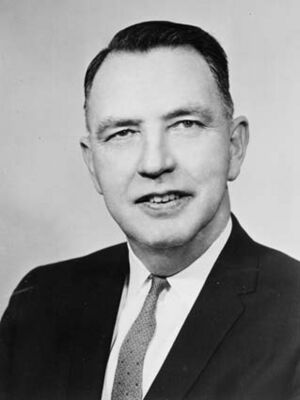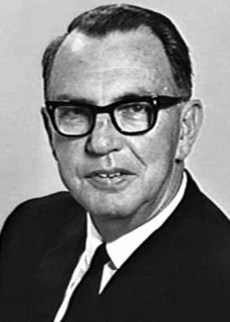Jack Renshaw facts for kids
Quick facts for kids
Jack Renshaw
|
|
|---|---|
 |
|
| 31st Premier of New South Wales | |
| In office 30 April 1964 – 13 May 1965 |
|
| Monarch | Elizabeth II |
| Governor | Sir Eric Woodward |
| Deputy | Pat Hills |
| Preceded by | Bob Heffron |
| Succeeded by | Robert Askin |
| Shire President of Coonabarabran | |
| In office 14 December 1939 – 15 May 1941 |
|
| Preceded by | William Thomas Neilson |
| Succeeded by | S. H. Regan |
| Councillor of the Coonabarabran Shire Council for C Riding | |
| In office 4 December 1937 – 2 December 1944 |
|
| Personal details | |
| Born | 8 August 1909 Wellington, New South Wales, Australia |
| Died | 28 July 1987 (aged 77) Northbridge, New South Wales, Australia |
| Political party | Labor Party |
John Brophy Renshaw (born August 8, 1909 – died July 28, 1987) was an Australian politician. He was a member of the Labor Party. He served as the Premier of New South Wales from April 30, 1964, to May 13, 1965. He was the first Premier of New South Wales to be born in the 1900s.
Contents
Early Life and Education
Jack Renshaw was born on August 8, 1909. This was near Wellington in central New South Wales. His parents were John Ignatius and Ann Renshaw. When he was six, his family moved to a farm near Binnaway. Five years later, his father died in a farm accident. This left his mother to raise eight children. After his mother remarried, the family did well. They owned a fuel station, a farm supply business, and a butcher shop in town.
Renshaw went to school at Binnaway Central School. He also attended Patrician Brothers in Orange. Later, he went to Holy Cross College in Ryde, Sydney. He left school at 14. He helped run the family's dairy farm and a milk delivery service.
Starting in Politics
Renshaw joined the Labor Party in Binnaway in 1930. He quickly became an important member. He also worked on state and federal election councils. He was President of the Gwydir Electorate Council from 1939 to 1949.
He was active in local government too. He served as a councillor for the Coonabarabran Shire Council from 1937 to 1944. From 1939 to 1941, he was the Shire President. At that time, he was the youngest shire president in Australia. He resigned in May 1941 when he was elected to the state Parliament. In the late 1930s, he also worked for the Wheat Growers' Union. In 1939, he tried to join the army for World War II. However, he was not accepted because of his eyesight.
Becoming a State Politician
William Scully, a federal politician, encouraged Renshaw to run for state parliament. Renshaw had helped Scully with his election campaigns. The Premier, William McKell, also supported Renshaw. McKell knew Renshaw's strong local ties would help him win.
Renshaw ran in the 1941 election. He won the seat of Castlereagh. He defeated Alfred Yeo from the Country Party. Yeo had held the seat for nine years. From 1945 to 1950, Renshaw was part of the Labor Party's main committee in New South Wales.
Working in Government
In 1950, Premier James McGirr made Renshaw the Secretary for Lands. Renshaw knew a lot about farming and rural areas. He strongly supported the Labor Party's plan to take over large properties. This was called compulsory resumption. The idea was to divide these large lands into smaller farms. People believed this would help rural areas grow and solve food shortages after the war. Wealthy farmers and the Country Party opposed this plan.
The new Premier, Joe Cahill, was impressed by Renshaw. In 1952, Cahill promoted Renshaw to Secretary for Public Works. In 1953, he also became Minister for Local Government. Later, in 1956, he moved from Public Works to Minister for Highways.
Renshaw became Deputy Premier from 1959 to 1964. This was when Bob Heffron was Premier. He also served as Treasurer from 1959 to 1965. He was also Minister for Lands (1960–1961), Minister for Agriculture (1961–1962), and Minister for Industrial Development and Decentralisation (1962–1965).
Premier of New South Wales
When Heffron retired in April 1964, Renshaw became Premier. However, his time as Premier was short. The Labor Party had been in power since 1941 and was seen as tired. Many of Renshaw's cabinet members were older. Six of the 16 ministers were 65 or older. Most had been in government for a long time.
Renshaw waited as long as he could before calling an election. The election was held on May 1, 1965. The Liberal leader, Bob Askin, used the slogan "Twenty-four years of Labor misrule." Renshaw found it hard to connect with city voters. He also struggled with television interviews. Askin, however, was very good on TV.
In the election, Labor lost nine seats. The Liberal-Country Party Coalition gained support from two independent politicians. This allowed Askin to become Premier. For the first time in 24 years, the Labor Party was out of power in New South Wales.
Renshaw was the last Labor Premier who did not work with a Labor Prime Minister during his time in office.
Renshaw lost another election to Askin in 1968. He resigned soon after this election. Pat Hills, the former Deputy Premier, took over as leader. However, Renshaw remained an important figure. He served as Treasurer again from 1976 to 1980 under Premier Neville Wran. After that, he worked as the state's Agent-General in London until 1983.
Personal Life
On November 12, 1942, Renshaw married Hilda May Wall. They had one son. Hilda died in April 1964, just weeks before Renshaw became Premier. On April 11, 1966, he married his second wife, Marjorie (Meg) Mackay. She had three children from a previous marriage, and they had one child together. Renshaw died in 1987 at the age of 77. He passed away in Northbridge, a suburb in northern Sydney.
In 2022, Catherine Renshaw, who is married to Jack Renshaw's son John, ran for a federal seat in North Sydney. She was not successful.
Honours and Legacy
- In 1979, Renshaw was honored as a Companion of the Order of Australia (AC). This is a very high award.
- John Renshaw Drive, a road in the Hunter Valley near the Pacific Highway, is named after him.
- The Jack Renshaw Bridge across the Castlereagh River at Gilgandra is also named in his honor.


